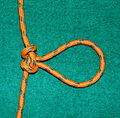Butterfly knot
| Butterfly knot | |
|---|---|

|
|
| Type | loop |
| application | Loop in the middle of the rope |
| Ashley No. | 331, 532, 1053 |
| English | Alpine Butterfly Knot |
| List of nodes | |
The butterfly knot is a knot used to create a loop in the middle of a rope . It is also suitable for connecting two ropes of the same type.
Knot
Placed with one hand
Place the rope over your left hand, palm up, and wrap one end of the rope around your palm twice. From above you can now see three ropes running over the palm. The one closest to the wrist is now placed over the middle rope. Now you grab the former middle, now left rope, put it over the other two ropes towards your finger and guide it on the surface of your hand under the other two ropes back towards your wrist. This rope can now be held in place as a loop while the rest of the rope is removed from the hand.
Finally tighten the ends to the outside and you get the "butterfly" (wing on the right, wing on the left and the actual loop are the antennae).
Placed with two hands
The rope is placed over the left hand with the palm facing up. Now you wind the rope, which is hanging down from your index finger, around your hand twice. Three ropes now run across the palm. Take the rope closest to your fingertips and pull it towards you ball of your hand over the two other ropes. Then take the loop that has been created and pull it back under the two other ropes. The ends are then only tightened outwards.
Laid, alternative
To knot, you take a bay and let the ends hang down to the right and left. Take the left side with your left hand and turn the bay 180 ° so that two eyes are created. Then you put your left thumb over the crossover in the loop that has just formed. Then turn the loop again by 180 ° in the same direction of rotation. Now fold the upper part of the loop forward and down so that the two crossing points are not moved. The part that has just been folded down then forms the fixed loop. Now put the right hand between the crossover points (where the left thumb is) through the whole knot (also through the hanging loop). The right hand grabs the hanging loop under the entrance ropes and pulls it out through the central opening. Finally, tighten the ends outwards.
Plugged in
This method is used to join two identical ropes together. In this form it becomes clear where the node got its name from.
First you create a bay with each of the ropes and interlock them. The rope then go around the cable and the formed from the bays eye. When looking at the details you can see two intertwined overhand knots , which with one modification (end position of the loose ends ) resemble the zeppelin knot .
application
Even after loading, the knot is easy to loosen again (by folding the "wings"). Because of the reliability of this knot, it is often used by climbers.
By stringing together several butterfly knots, a rope ladder replacement can also be made with these as "climbing loops".
The butterfly knot is suitable as a braking knot for glacier visits. Its special shape should increase the braking effect in firn.
Alternatives
Climbers use the figure eight knot or double bulin as an end loop for roping up . To connect two ropes when abseiling comes blind stitch used.
One - or even two - fixed loops in the middle of a rope can be created with the double bowline .
The Zeppelinstek is better suited as a rope connection . It is more stable and has a slimmer shape.
Individual evidence
- ↑ a b butterfly knot. In: kommerell.de. Retrieved May 1, 2015 .
- ↑ Clifford Ashley: The Ashley Book of Knots . Number 428.
- ↑ Bernd Eberle: Who else falls into the column ... In: DAV Panorama . No. 4 , 2015, p. 56 ( PDF [accessed October 9, 2015]).
- ↑ Which knot holds best? In: spectrum. January 30, 2020, accessed February 2, 2020 .







